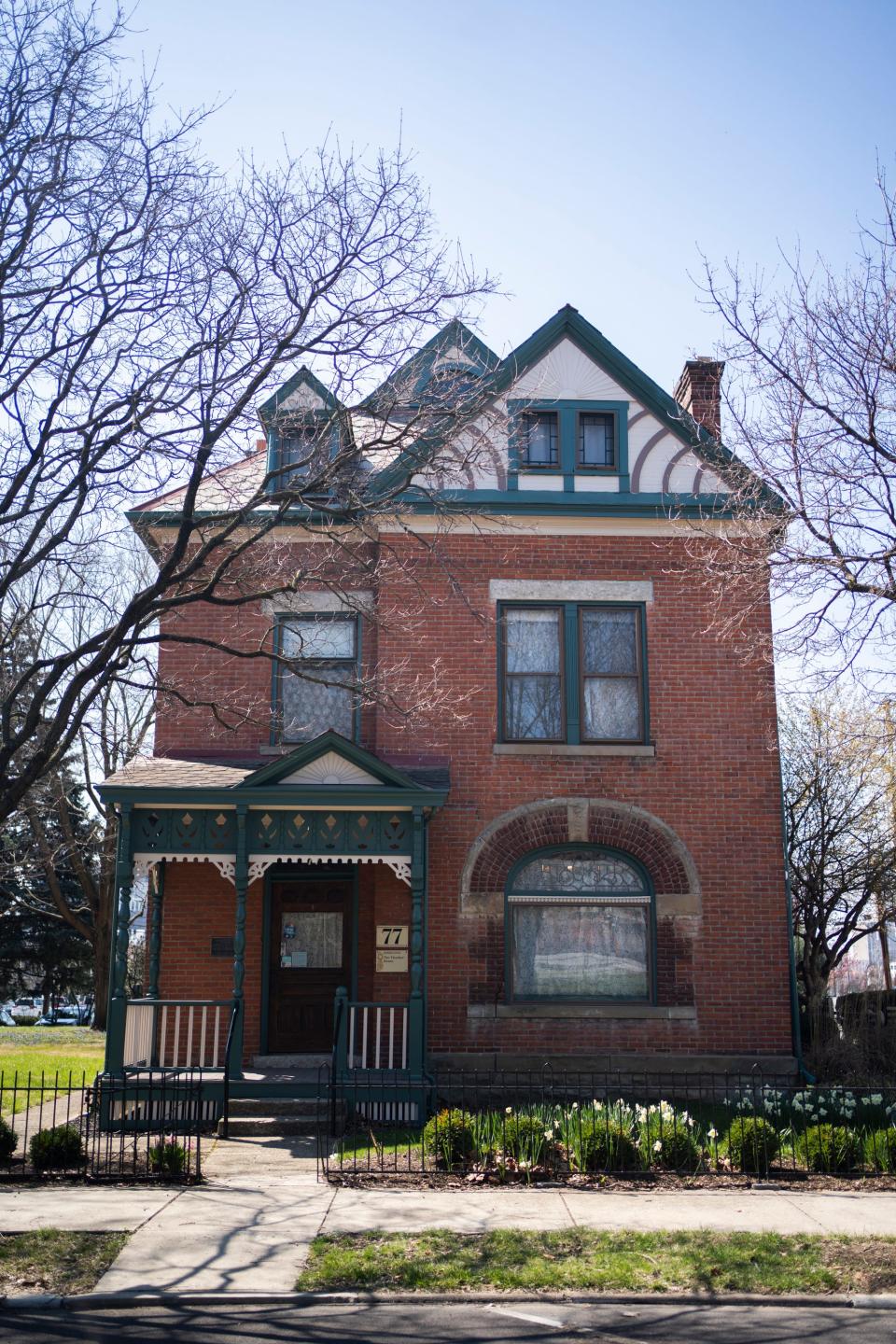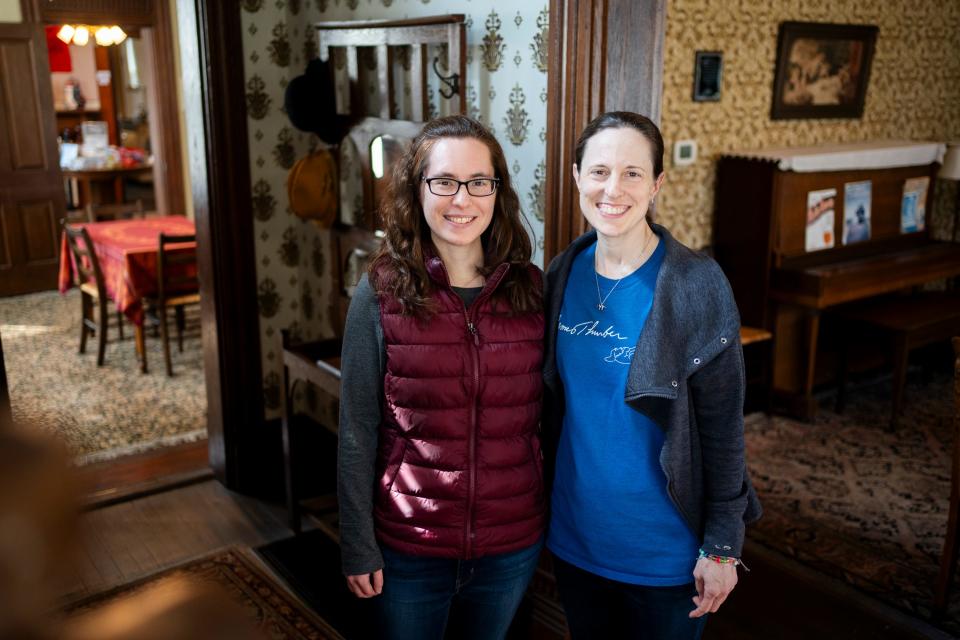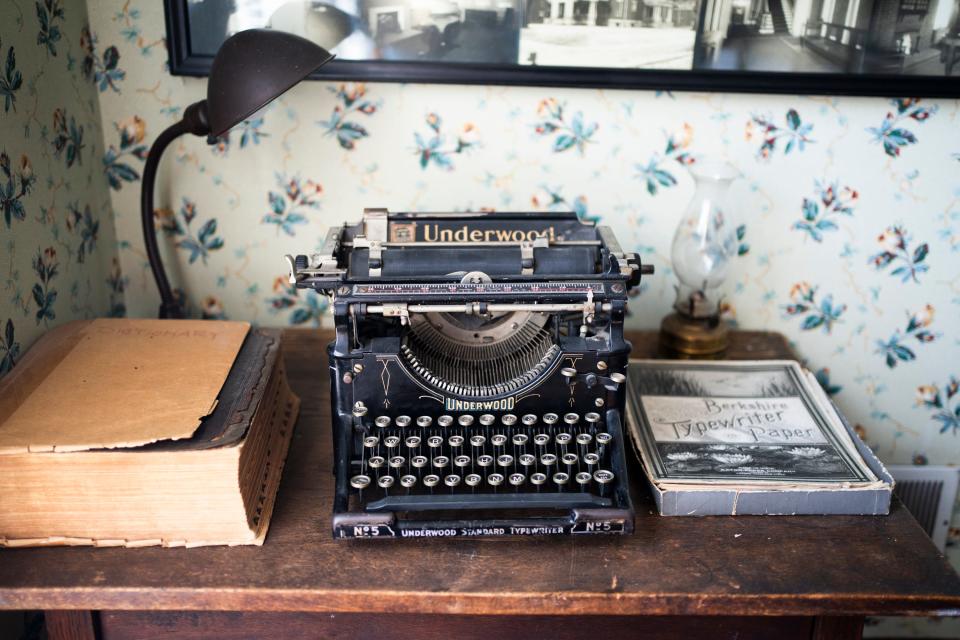40 years in the making, Thurber House benefits readers and writers
This year, Columbus-born writer, playwright and cartoonist James Thurber would have turned 130.
Thurber was born in 1894 and died, at age 66, in 1961. By comparison, the area nonprofit arts organization that bears his name is just barely entering middle age.
Thurber House will turn 40 this year. The organization, headquartered in a home once occupied by the writer and his family, was founded to further the interest in Thurber. Today, Thurber House functions as both a museum and a literary center, with the primary goal to mandate in promoting writing, authors and books, goes beyond Thurber himself.
During this year of anniversaries, The Dispatch spoke with past and present officials at, or associated with, Thurber House.

Who was James Thurber?
The son of Charles and Mary Thurber, James Grover Thurber spent his childhood, college days and young adulthood in Columbus. From 1913 through 1918, he was a student at The Ohio State University, and in the early 1920s, he cut his teeth as a reporter for The Dispatch.
In 1926, he pulled up stakes for New York, where he caught on at The New Yorker magazine and began writing the short fiction that would lead to a following around the globe.
What was Thurber best known for?
Thurber published a panoply of books during his lifetime, including “Is Sex Necessary?,” with E.B. White; “My Life and Hard Times;” “My World ? And Welcome to It;” and “The Years with Ross,” a memoir of New Yorker editor Harold Ross.
His short story, “The Secret Life of Walter Mitty,” was twice inspiration for feature films; a 1947 version starred Danny Kaye, and a 2013 version starred Ben Stiller. Much of his writing makes reference to his roots in Columbus, including the tales in “My Life and Hard Times.”
Concurrent with his writing career, Thurber drew cartoons that often portrayed combative couples and unusually intelligent canines.
When did Thurber live in what is now Thurber House?
Thurber House was once merely the Thurbers’ home. The three-story residence, built in 1873 and standing at 77 Jefferson Ave., was occupied by the family from 1913 through 1917, a period that overlapped with James’ time at Ohio State.
Downtown happenings: Columbus College of Art and Design plans $15 million renovation for new learning space
The stories “The Night the Ghost Got In” and “The Night the Bed Fell” are set in this house.
What are the origins of Thurber House?
For more than 60 years, the house was a home to other families and was occasionally used for commercial purposes, including as a rooming house and beauty shop. It had not been kept up.
“The house almost was torn down by the city because it was in such bad shape,” said former Dispatch editor Luke Feck, who served on a steering committee for Thurber House.
In the 1970s, Columbus attorney Arthur Vorys acquired the house, along with adjacent properties on Jefferson Avenue, and plans for Thurber House were soon underway.
What work was necessary to renovate Thurber House?
Before Thurber House could be turned into a museum and a literary center, the building itself first needed attention ? lots of it.
“The first time I walked through the house, my foot fell through the floor,” Feck said. “It was in a sad, sad state. The doors to all the rooms had numbers on them from when it was a rooming house.”
A renovation process lasted for about two years. In addition to making improvements, leaders, including Founding Executive Director Donn Vickers, also sought to return the house to some semblance of what it had been when the Thurbers had resided there.
“(James’ brother) Robert Thurber was still alive when they bought the house,” said Thurber expert James Tootle. “As the renovators were steaming the wallpaper off, they kept going layer by layer by layer, and then Robert goes, ‘That’s it! . . . That’s the one we had when we were here.’”
Although the Thurbers’ original furniture was gone, efforts were made to acquire antiques.
“The house is a pretty accurate representation of what it was when Thurber lived there,” Tootle said.
What were some of Thurber House’s main programs?
In addition to saving the house and presenting it in a manner that reflected the era in which the Thurbers lived there, Thurber House leaders also wanted the building to be bursting with activity.
“We were thinking about programs from the start,” Feck said.
Thurber House initially distinguished itself on the local literary landscape by hosting authors to read from, or talk about, their work.
“There weren’t independent bookstores doing readings (in the 1980s),” said Michael J. Rosen, Thurber House’s founding literary director. “(Thurber House leaders) wanted to bring living writers to the community to have readings.”
An “Evenings with Authors” series featured nationally known writers, and a “Literary Picnic” series presented Ohio authors.
“We wanted to salute Thurber’s tradition of humor writing, so we always wanted to have someone for whom humor was the primary genre ? not just a novel that happened to have some funny things in it,” Rosen said. “We pursued and brought luminaries.”
Author-residency programs were also established to enable writers to set up shop in a two-bedroom apartment within Thurber House.
“There was no literary culture center in central Ohio,” Rosen said. “There was a place for music, a place for dance, a place for art, but we wanted to have a place for writers and readers and literature.”
Who are some famous authors to have visited Thurber House?
Among the writers to have appeared at, or been invited by, Thurber House are Hanif Abdurraqib, Russell Baker, Dave Barry, Art Buchwald, Nikki Giovanni, Garrison Keillor, Fran Lebowitz, P.J. O’Rourke, Amy Tan and John Updike.
More: Here are some of Ohio State's most famous alumni, from authors to athletes to actors
What is the Thurber Prize for American Humor?
Since first being given in 1997, the Thurber House-sponsored and –produced Thurber Prize for American Humor has been awarded to humorists who might be considered heirs to Thurber.
Past winners include David Sedaris (2001), Christopher Buckley (2004), Joe Keenan (2007), Calvin Trillin (2012) and Trevor Noah (2017).

The next edition of the prize is to be given May 31 at the Columbus Museum of Art. To recognize Thurber’s cartooning legacy, a second prize is to also be given to a cartoonist, starting this year.
What is the organization’s mission today?
Although Thurber House still revolves around celebrating its namesake, the organization today has an increasingly diverse sense of mission.
Executive Director Laurie Lathan sees the literary center’s educational programming as a priority going forward.
“Bringing that to the forefront, and the community knowing how many children need help with their overall literacy in their education, that’s one of the focuses that we will be emphasizing in the coming years,” Lathan said.
Thurber House’s annual Summer Writing Camp is tailored for those in grades two through nine, and a Young Writers’ Studio program is aimed at those in grades nine through 12. Adult-writing workshops are also offered.
Authors continue to stream through Thurber House, but as bookstores and libraries increasingly host writers, the organization now aims to attract a broader, more high-profile swath of guests.
“Where we cover our costs is through admission fees,” Lathan said. “We can’t charge people upwards of 70 dollars if there’s not an experience attached to it.”
Upcoming author appearances include thriller writer Harlan Coben (May 21 at Ohio Dominican University) and former FBI assistant director Frank Figliuzzi (June 20 at Thurber Center).
“There’s a lot going on,” Tootle said. “It’s not just a museum... It’s a dynamic, living, energetic place.”
What is the future of Thurber House?
Like nearly all arts organizations, Thurber House had a rocky road during the pandemic.
“Coming out of the pandemic, it’s been so, so challenging for Thurber House,” said Lathan. “We did end up getting some emergency funding from the state and the local government to help carry us over through that year.”
Today, the budget is between $550,000 and $600,000, Lathan said.
“We need to be back up at that $800,000 mark,” she said. “It’s just a challenge in this climate to get there, when folks are watching where they spend their money and where they go.”
And, because 40 years have passed since the renovation of Thurber House, the structure itself should soon need some attention.
“This is an historical home, and essentially it has not been touched since 1984,” Lathan said. “The wallpaper, in some areas, is starting to peel. We are going to need some help with that in the near future. With homes, with buildings, they need ongoing care.”

Nonetheless, Lathan is optimistic about Thurber House’s future.
“We are constantly trying to figure out how to reach new audiences,” Lathan said. “Our long-term patrons are phasing out, so how do we capture the younger folks?”
Why is James Thurber still relevant today?
Although Thurber’s peak days of popularity have long passed, his admirers say his work remains readable and relevant.
“He simplifies life to the absurdity that it is,” Feck said. “(His stories) are beautifully, simply written, and they go on to capture what’s crazy about this world.”
Plus, according to Tootle, Thurber’s stories contribute to our understanding of Columbus during days gone by.
“He’s so much fun,” Tootle said. “It’s not thick, heavy writing. They’re delightful stories that are wonderful to read, and you laugh out loud while you’re reading them, but you absorb all this knowledge.”
At a glance
Thurber House, 77 Jefferson Ave., is open to visitors from 1 to 4 p.m. Tuesdays, Thursdays, Saturdays and Sundays. Admission is $5.
For a full list of current programs and events, visit thurberhouse.org.
This article originally appeared on The Columbus Dispatch: Thurber House celebrates 40th anniversary